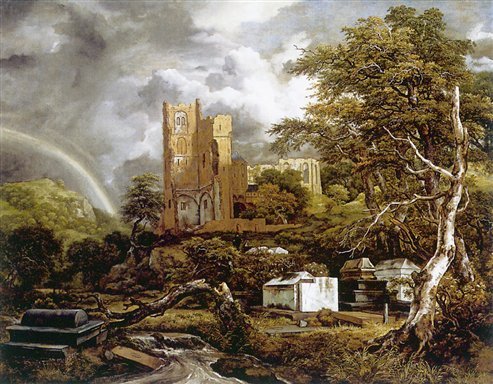81. Jacob van Ruisdael,
The Jewish Cemetery at Ouderkerk, 1653-1655.
Oil on canvas, 84 x 95 cm.
Gemäldegalerie Alte Meister, Dresden.
A further specialist among the Amsterdam landscape painters was Jan van der Heyden, who, with pedantic accuracy, painted the canals and streets of the Dutch towns. He also painted the palaces on the land with soulful feeling and showing beautiful summer lighting and excellent mastery of perspective. He can thus be counted among the great architectural painters such as Emanuel de Witte, who also belonged to the Amsterdam school and mainly painted church interiors. In contrast, others came from the Haarlem school such as the brothers Job and Gerrit Berckheyde, who mainly painted church interiors and town views.
The Specialists under the Painters
In order to gain a better overview of the large number of Dutch painters, they have been divided into their particular specialities. In addition to the genre, landscape and architectural painters, there are also the sea, animal and still-life painters, who all contributed to the macrocosms of the large category of Dutch painting.
The origin of sea painting was in Amsterdam. Working there were Simon de Vlieger, Jan van de Capelle and Ludolf Backhuysen, who was the first to introduce the dramatic element in marine painting, of storms with shipwrecks, sea battles or harbours full of ships as in the View of Amsterdam. Without doubt, the best of the marine painters was Willem van de Velde the Younger, a pupil of Simon de Vlieger who went to London in 1672 and was named Court Painter to the English king five years later.
Vlieger was far in advance of all his predecessors in the depiction of still seas occupied only by anchored or slowly gliding ships; he was a first class colourist who knew how to display the play of the veiled sunlight over the seemingly sleeping water with great mastery. In these quiet waters the living figures were mostly frigates with full tackle and fisher boats or smaller merchant ships. In the work Cannon Shot (c. 1670), Vlieger skilfully presented the relative calmness of the sea even after cannon fire.
The great Dutch animal painters were also great landscape painters. At the head of the group was Aelbert Cuyp, who was born in Dordrecht as the son of the portraitist Jacob Gerritsz Cuyp, and who was called the “Dutch Claude Lorrain” because of his love for reproduction of the glowing, swimming sun over his landscapes. Although Cuyp also painted individual animals and still-lifes, his strength lay without doubt in the landscapes always occupied by shepherds, hunters, horses or cattle, and also his pictures of rivers in the glow of the midday sun and of ships against the mild sinking evening sun. He competed in the effects of light and his broad, fluid handling with Jan van Goyen, whom he later surpassed in skill. Among the finest of the just as expensively sold pictures as those of Hobbema and Ruisdael, are the works Cow Pasture (c. 1650) and Departure for the Hunt. Cuyp lived his whole life in Dordrecht where, in contrast to many of his artist friends, he died admired and showered with honours by his fellow citizens.
Adriaen van de Velde, a brother of the aforementioned marine painter Willem van de Velde, was an excellent landscape painter, who liked to enliven his wood landscapes with horses and cattle and thus belongs to the animal painters. He was able to paint the summery ambience over woods, water, and meadows in pieces such as the River Landscape with Horses and Sheep, and painted just as excellent winter pictures with sled riders and skaters.
As a painter of animals he took as his model the best of Dutch animal painters, Paulus Potter. Although Potter obviously liked to paint life-size pictures, the emphasis of his activity was in the idyllic depiction on a smaller scale, of homely meadows with horses, cattle and sheep. His most famous picture The young Steer belongs to his body of work with life-size figures and is powerfully presented with an astounding care in the depiction of all the details. However, this picture is surpassed in pictorial attraction by another of his works, the Cow mirroring Itself. The last years of his short restless life were spent in Amsterdam and he was thus able to exert a certain influence of the school there.
